On Friday, four key leaders in education and government are gathering to discuss the impact of federal stimulus dollars that Texas schools will finally have access to.
This comes after Gov. Greg Abbott and state leaders agreed to pass along billions of dollars from the federal government that was just sitting in Austin.
It was just days ago that district leaders were pleading with state leaders to have access to that federal money, which totals $20 billion for Texas for schools.
The advocacy group Raise Your Hand Texas is bringing together Dallas ISD superintendent Michael Hinojosa, Texas Sen. Royce West (D), Michelle Vopni of the Dallas Regional Chamber and DISD board president Justin Henry.
Get top local stories in DFW delivered to you every morning. Sign up for NBC DFW's News Headlines newsletter.
All four will be discussing how to best distribute those stimulus dollars into local school districts and communities, now that it's available.
Dallas ISD stands to gain $500 million alone.
The district has said they will use a portion of that to help pay for cell towers to connect more students in Dallas to the internet permanently. As part of Operation Connectivity, DISD is working to create a private cell network with high-speed internet for up to five Dallas communities that need it most.
Local
The latest news from around North Texas.
That's a cause Sen. West has been behind. In fact, he's been sponsoring a "Get Connected" campaign since last year to help families find reliable internet access throughout the pandemic.
Superintendent Hinojosa and other district leaders also addressed this in their virtual State of the District this week.
“When we hit the pandemic, all of the sudden, we've discovered that 36,000 households did not have access to broadband. And if you wanted to learn, if you wanted to go to the doctor, or apply for a job – you needed to be able to be connected,” he said.
Superintendent Hinojosa also spoke to NBC 5 about other ways they need to use the money.
"Twenty-five percent of this money has to be on learning loss but I project over half of it will be on learning loss,” he said. “How do we get caught up, how do we redesign summer school? That way, we can pay our best teachers to stay with the kids. And we'll have plenty of resources to make this happen so they can get some success with their students."
The schools will get two-thirds of the cash now. The rest will come later. Each district will find its own use. A mix of paying past bills and helping students dig out of their learning losses.



